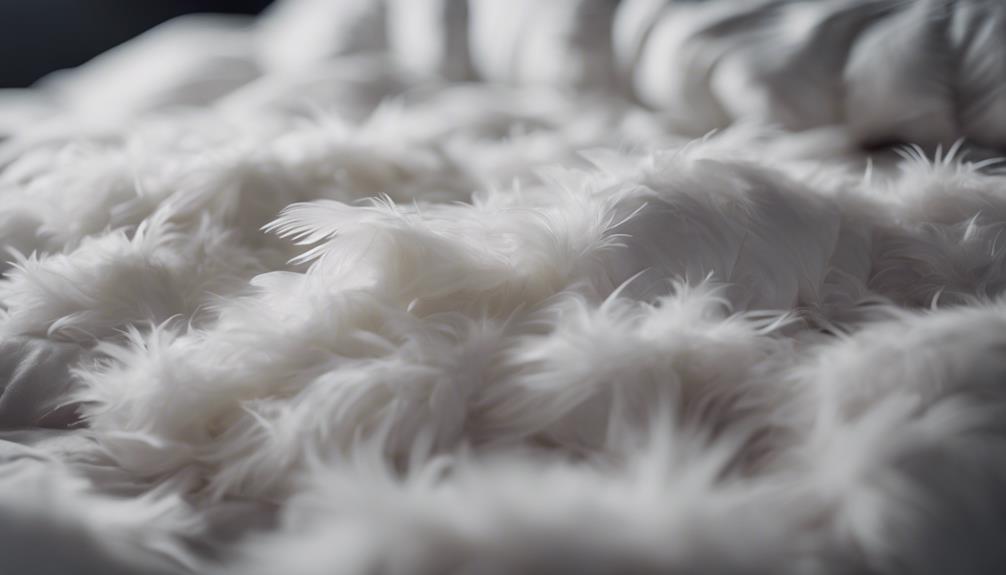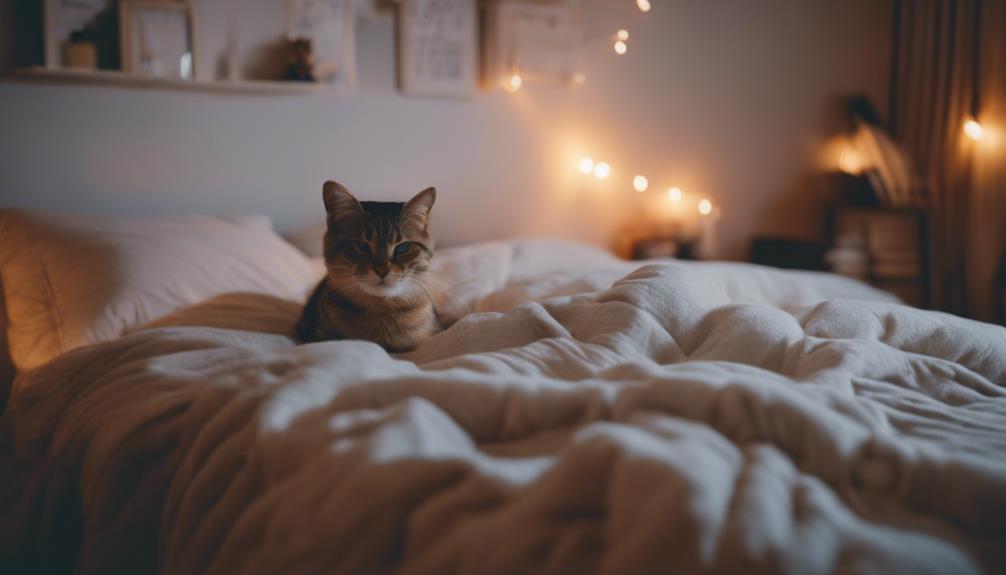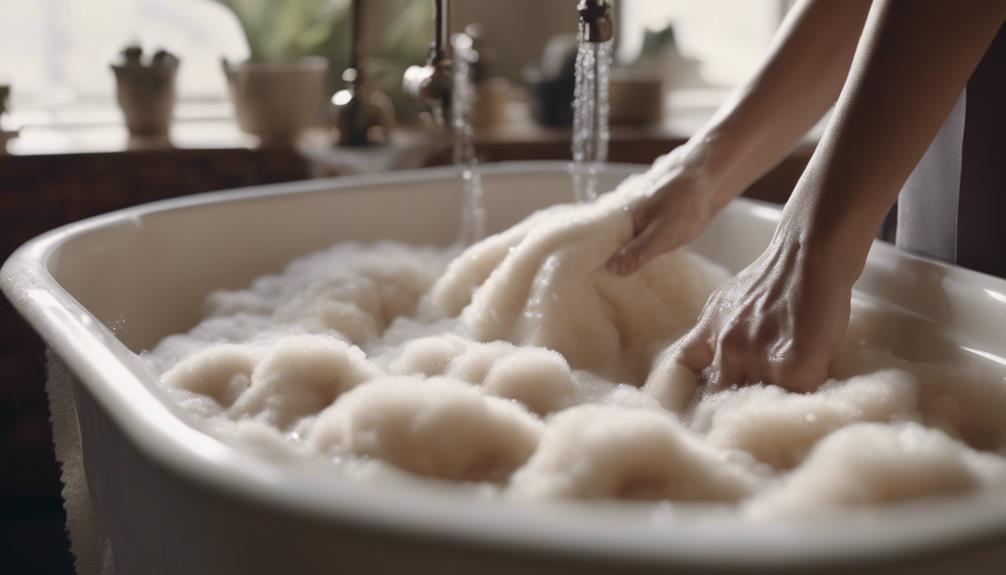If your down comforter is lumpy, it could be due to various reasons. Using tennis balls in the dryer can prevent clumping, while not shaking it enough after washing leads to lumps. Opt for high-quality down comforters with even filling distribution to avoid this issue. Improper washing techniques, like using fabric softeners, can also cause lumps. Fluff and shake your comforter regularly to prevent clumps and maintain loftiness. Improper drying methods can also lead to lumpiness, so follow care label instructions closely. These tips can help you understand and resolve the lumps in your down comforter.
Key Takeaways
- Use tennis balls or dryer balls in the dryer to prevent clumping.
- Insufficient shaking after washing leads to lumpy areas.
- Opt for high-quality down comforters with even filling distribution.
- Improper drying methods can cause lumpy comforters.
- Regular fluffing and shaking prevent uneven down filling distribution.
Common Causes of Lumpy Down Comforters
Lumpy down comforters often result from common mistakes made during the washing and drying process. When tossing your comforter into the dryer, it's important to add a few clean tennis balls or dryer balls. These items help prevent the down clusters from clumping together, ensuring a more evenly distributed fluff.
Insufficient shaking and fluffing after washing can lead to lumpy areas in the comforter. So, make sure to give your comforter a good shake before placing it in the dryer. Additionally, using a low heat setting and periodically stopping the dryer to manually fluff the comforter can help maintain its loftiness and prevent lumps.
Poor quality down or uneven distribution of filling can also cause lumps to form in the comforter. To prevent this, opt for high-quality down comforters with evenly distributed filling to minimize the risk of lumps forming over time. Proper care, including regular maintenance and following correct washing and drying techniques, is essential in preventing and reducing lumps in down comforters.
Impact of Improper Washing Techniques
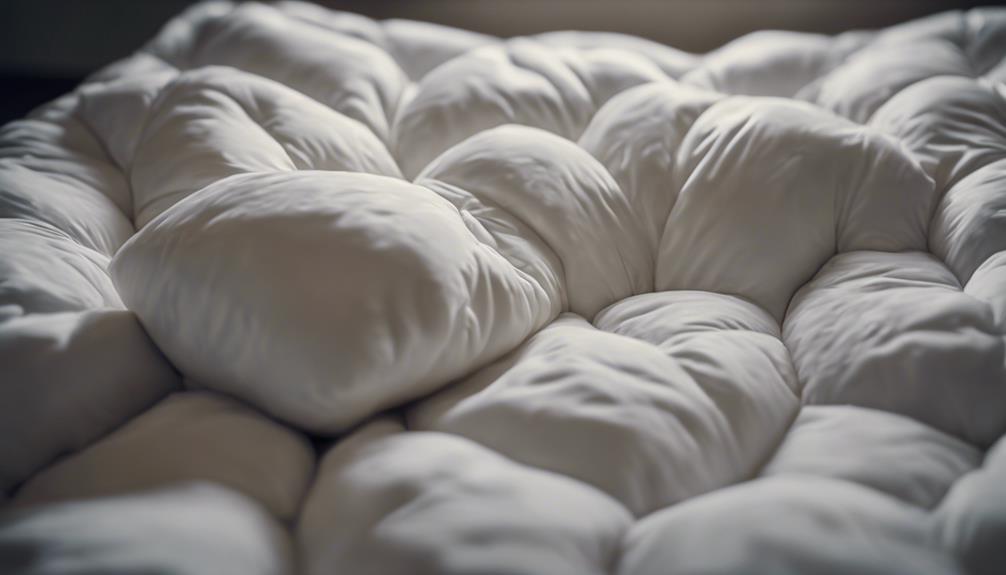
Improper washing techniques can lead to down clusters clumping together, resulting in a lumpy comforter. When cleaning a down comforter, it's important to use a mild detergent and avoid fabric softeners that can leave residues affecting the fluffiness of the down.
Following the washing instructions on the care label is necessary to prevent lumps and guarantee even distribution of filling. Improper drying methods can also contribute to a lumpy comforter, as dampness can lead to mold growth.
To fluff a down comforter properly, it should be dried thoroughly and in line with the manufacturer's recommendations. Regular cleaning and proper washing techniques are essential to maintain the loftiness and overall quality of a down comforter. By following these guidelines, you can ensure a clean comforter that stays fluffy and comfortable.
Uneven Distribution of Down Filling
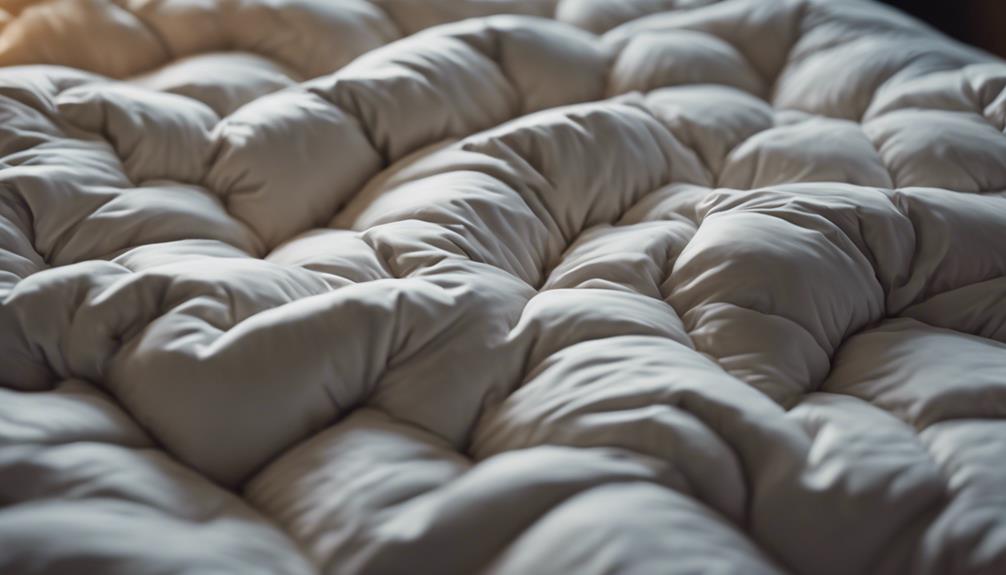
When examining a down comforter, one can often notice an uneven distribution of the down filling inside the comforter. This uneven distribution can lead to clumps forming in the comforter when the down filling shifts or bunches up in certain areas. To help understand this better, let's look at the following table:
| Issue | Cause | Prevention |
|---|---|---|
| Uneven Distribution | Down filling shifting or bunching up in certain areas | Regularly fluff and shake the comforter |
| Clumps Formation | Down filling sticking together due to improper washing or drying techniques | Use proper washing and drying methods |
| Quality of Construction | Comforters with proper stitching or baffling are less likely to develop lumps | Invest in high-quality comforters with secure stitching |
To prevent lumps caused by uneven distribution of down filling, it is important to follow proper care techniques and invest in well-constructed comforters. Regularly fluffing and shaking the comforter can help redistribute the down filling, maintaining its loftiness and preventing clumps from forming.
Overuse and Wear of Comforter
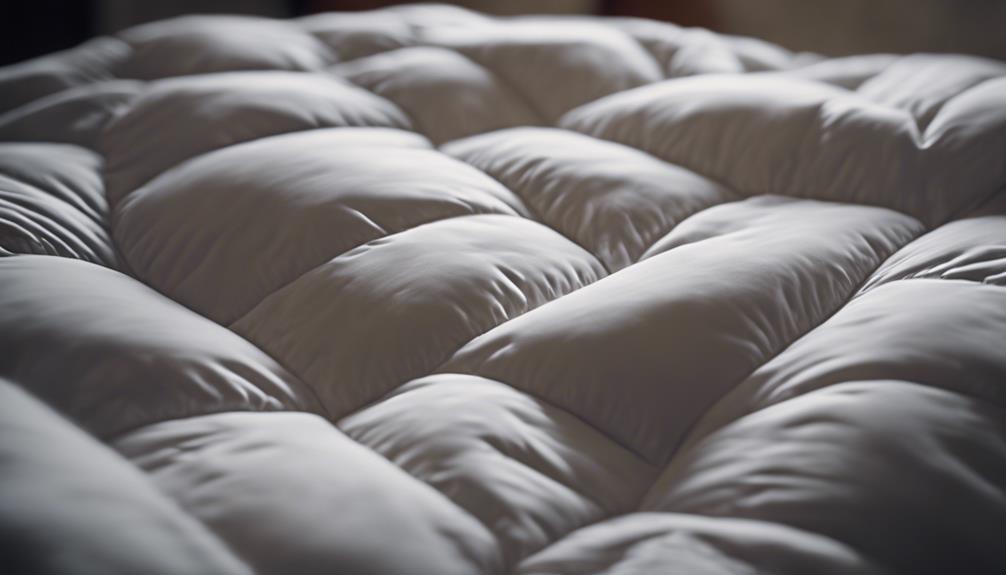
Continuous use of a down comforter under pressure can result in the formation of lumps within the filling. Over time, the down inside the comforter can clump together due to constant compression from activities like sleeping, sitting, or folding. These lumpy areas develop when the down shifts and compacts unevenly, leading to an uncomfortable sleeping experience. Additionally, lack of proper care, such as infrequent washing and airing out, can contribute to the formation of lumps in the comforter.
To prevent or reduce lumps caused by overuse and wear, it's essential to regularly rotate and fluff the comforter. Rotating helps redistribute the down evenly, preventing it from clumping in specific areas. Fluffing the comforter, either by hand or using the air fluff setting in a wool dryer, can also help maintain the loftiness of the down filling and prevent it from becoming too compacted. By taking these simple steps, you can prolong the lifespan of your down comforter and guarantee a more comfortable sleep experience.
How Drying Methods Affect Lumpiness
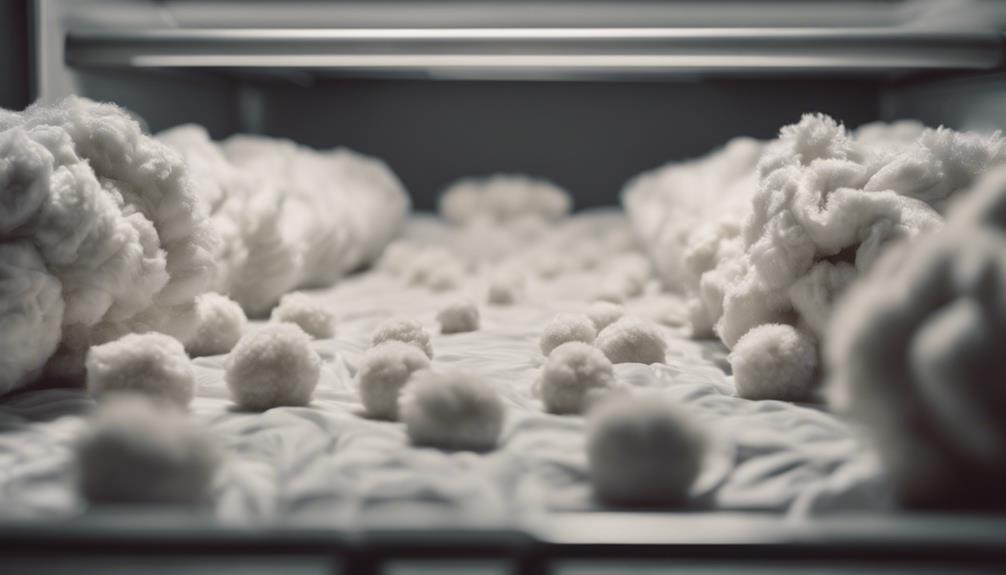
Exploring how different drying methods impact the lumpiness of a down comforter reveals significant insights into maintaining its quality and comfort.
When putting your comforter in the dryer, using the air fluff setting can help keep it fluffy and prevent clumping. Additionally, incorporating wool dryer balls or tennis balls into the drying process can assist in minimizing lumps. These items help fluff up the comforter and prevent down clusters from sticking together.
It's essential to avoid high heat or over-drying, as these improper techniques can actually increase lumpiness by damaging the down clusters. Following the manufacturer's recommendations for drying your comforter is vital for preserving its loftiness and reducing the formation of lumps.
Preventive Care Tips for Comforter
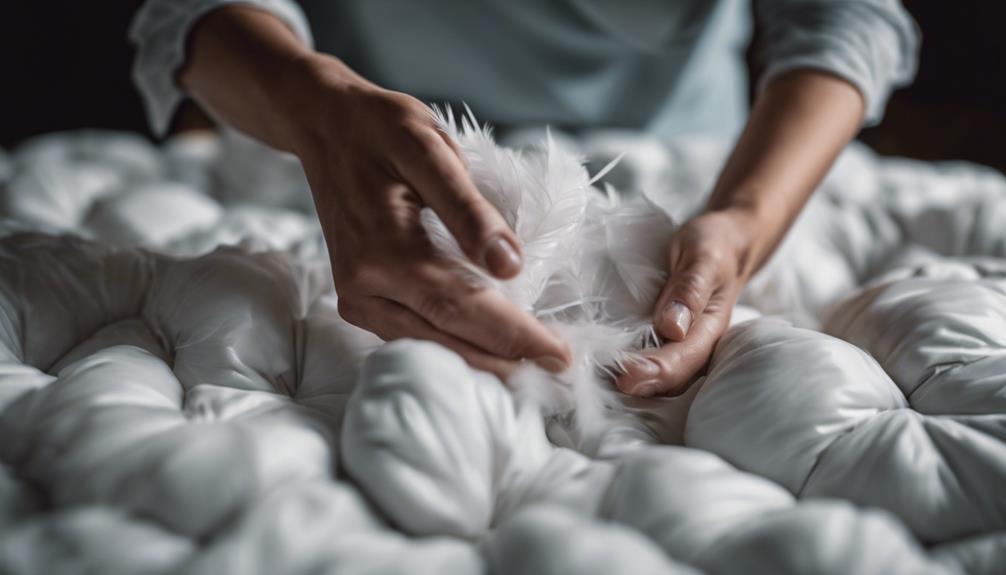
To keep your comforter fluffy and lump-free, remember to shake and fluff it regularly to prevent down from clumping together.
Also, rotating your comforter every 2-3 nights helps distribute the filling evenly and avoids lumps in one spot.
Following the care instructions on the label when washing and drying your comforter is essential for maintaining its loftiness and preventing lumps.
Fluffing Technique for Maintenance
Regularly fluffing our down comforter is crucial to maintaining its loftiness and preventing the formation of lumps. To keep our comforter in top shape, we can use the shake and fluff method, rotate it every 2-3 nights, and follow proper washing and drying techniques.
Here's a simple guide to help care for your comforter:
- Shake and Fluff: Vigorously shake the comforter to redistribute the fill and prevent bunching.
- Rotate Regularly: Rotate the comforter every 2-3 nights to guarantee even distribution of fill.
- Washing and Drying: Use mild detergent and tennis balls inside the dryer to break down clumps and maintain the comforter's fluffiness.
Proper Storage Methods
Using a breathable cotton storage bag is essential for preventing moisture buildup and mildew when storing your down comforter. Avoid compressing the comforter by storing it in a spacious area with good air circulation to maintain its fluffiness.
Store the comforter in a cool, dry place away from direct sunlight and heat sources to preserve the quality of the down fill. It's important to steer clear of plastic bags or containers, as they can trap moisture, leading to a musty odor and clumping of the fill.
Before storing, regularly fluff and shake the comforter to prevent the down from settling and forming lumps over time. Taking these steps will help your comforter or duvet look and feel fresh for longer.
Importance of Regular Fluffing
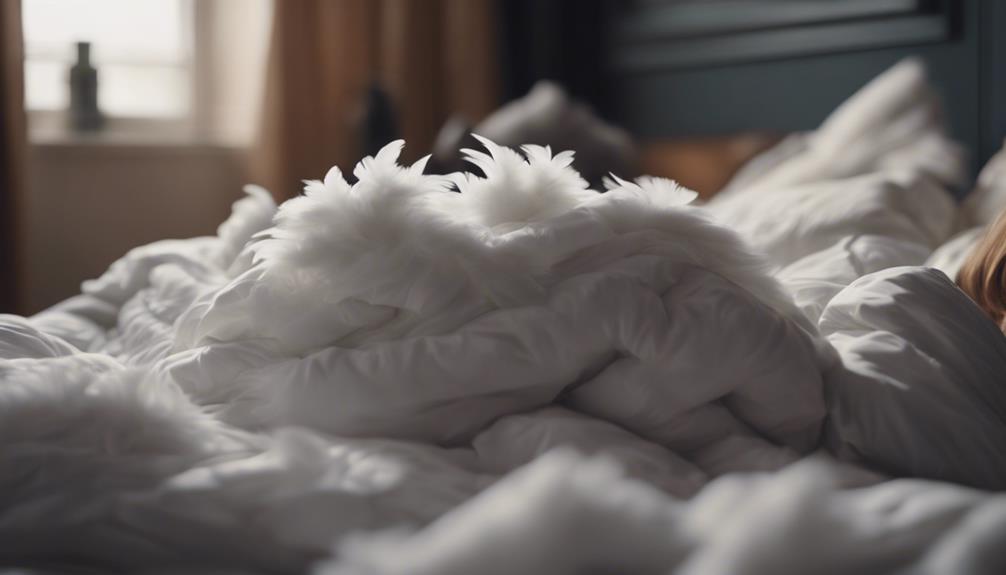
Regularly fluffing your down comforter is essential as it prevents clumping and maintains even distribution of the filling. This simple task helps to keep your comforter fluffy and guarantees consistent warmth and comfort.
Neglecting regular fluffing can result in lumps and uneven down distribution, affecting the overall quality and effectiveness of your comforter.
Fluffing Prevents Clumping
Fluffing your down comforter regularly is crucial to prevent clumping and maintain its comfort and longevity. When down feathers bunch together, it can lead to lumps in the comforter, affecting its overall feel. By redistributing the fill evenly through fluffing, you can restore loft, insulation, and comfort by expanding the feathers.
To guarantee your comforter stays in top condition, it's recommended to fluff it every 2-3 months. Proper fluffing not only prevents clumping but also preserves the comforter's lifespan by preventing matting. Remember to fluff your comforter after washing, when it appears flat, or as advised by the manufacturer.
Maintains Even Distribution
Maintaining even distribution of the fill in your down comforter through regular fluffing is essential for preventing lumps and ensuring peak comfort. To keep your comforter in top shape, gently shake and fluff it using your hands. This simple action helps the down or feathers inside to stay evenly spread out, avoiding those pesky lumps that can disrupt your sleep.
Not only does this enhance the appearance and comfort of your comforter, but it also maintains its warmth and insulation properties. By consistently fluffing your comforter every 2-3 months or as recommended by the manufacturer, you can extend its lifespan and enjoy a cozy and lump-free sleeping experience for years to come.
Significance of Proper Storage
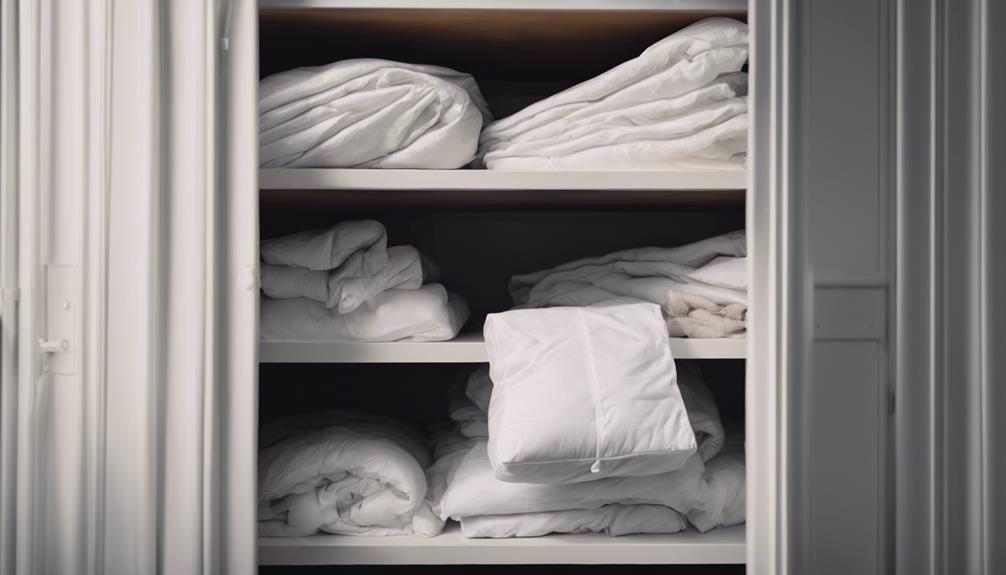
Why is proper storage essential for maintaining the quality of a down comforter? Proper storage is vital for preserving the loft and preventing lumps in a down comforter. Here are three key reasons why proper storage matters:
- Prevents Moisture Buildup: Storing a down comforter in a breathable cotton or linen bag helps prevent moisture buildup, which can lead to mildew growth and damage the comforter.
- Allows for Airflow: Avoid storing your down comforter in plastic bags or airtight containers as this restricts airflow. Adequate airflow is necessary for maintaining the fluffiness and quality of the comforter.
- Preserves Fluffiness: Hanging your comforter in a cool, dry place with good ventilation can help preserve its fluffiness. Additionally, regularly airing out and fluffing the comforter while stored can prevent clumping and help maintain its overall quality.
Professional Cleaning and Maintenance
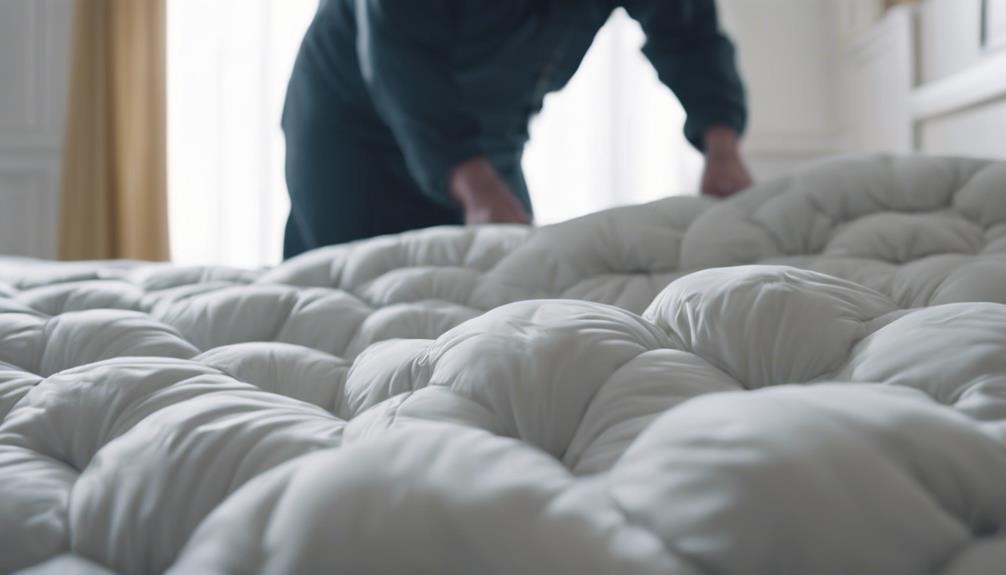
Professional cleaning and maintenance services play a crucial role in guaranteeing the longevity and quality of down comforters. These services help remove dirt, oils, and residue that can cause down comforters to become lumpy over time. By entrusting professionals with the cleaning process, you can prevent mold and mildew growth, which are common culprits of lumps in comforters. Professionals use specialized equipment and techniques to ensure a thorough cleaning process, maintaining the loftiness and shape of the comforter.
Regular maintenance services provided by professionals may include fluffing, re-distributing down fill, and repairing any stitching or baffling. These actions help restore the comforter's original shape and ensure top-notch comfort. By investing in professional cleaning and maintenance, you can extend the lifespan of your down comforter and keep it looking and feeling like new for a more extended period. It's a worthwhile investment to preserve the quality and coziness of your down comforter.
Frequently Asked Questions
How Do You Fix a Clumped Down Comforter?
When a down comforter gets clumped up, we can fix it by shaking and fluffing it to redistribute the fill evenly. Massaging the lumpy areas gently can help the feathers regain their fluffiness. Hanging the comforter outside or using a dryer on an air-fluff setting can also help.
Adding wool dryer balls or tennis balls can prevent clumping. Regularly fluffing and rotating the comforter keeps it fluffy and evenly distributed.
How to Fix Lumpy Comforter?
To fix a lumpy comforter, we should manually break apart clumps of filling by hand and gently shake the comforter to redistribute the filling evenly. Using a small pestle can help break up larger clumps within the comforter.
Hanging the comforter on a clothesline or using a dryer with an air-fluff setting can also eliminate lumps. Remember to regularly fluff the comforter every 2-3 months to maintain its loft, insulation, and overall comfort.
How to Keep a Comforter From Clumping?
To keep a comforter from clumping, rotate it frequently to maintain even distribution. Wash it in a front-loading machine with mild detergent to avoid clumping. Dry it with tennis balls for fluffiness and to break down clumps.
Shake it regularly to prevent feather bunching. Handle it gently when breaking down clumps to avoid damage. These tips will help your comforter stay fluffy and lumpy-free like a cloud in the sky.
How to Redistribute Down in a Comforter?
To redistribute down in a comforter, shake and fluff it vigorously to guarantee even distribution. Rotate the comforter every 2-3 nights to prevent clumping in one spot.
Wash and dry following label instructions to break down clumps. Be gentle with wet clumps to avoid damaging the filling.
Regularly fluff every 2-3 months to maintain loftiness and even distribution for long-term comfort.
Can Lumps in a Down Comforter Lead to It Going Flat?
Yes, lumps in down comforters go flat over time. The filling can shift, causing uneven distribution. To prevent this, regularly fluff the comforter. If lumps persist, consider a professional cleaning or repair service. Investing in a high-quality comforter will also help to maintain its loft and comfort.
Conclusion
To sum up, maintaining the fluffiness and lump-free state of your down comforter is crucial for a restful night's sleep. Make sure to regularly fluff and store it properly to preserve its quality.
Additionally, handle your comforter with care to avoid any damage or lumps. Therefore, keep your comforter fluffy and free of lumps for a cozy night's rest!
